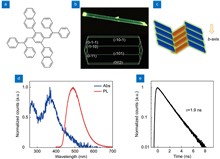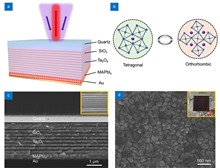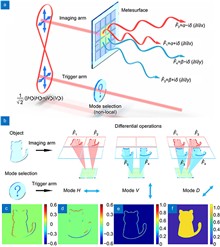 View fulltext
View fulltext
Efficient exciton transport over long distances is crucial for organic optoelectronics. Despite efforts to improve the transport properties of organic semiconductors, the limited exciton diffusion remains a significant obstacle for light-harvesting applications. In this study, we observe phenomena where exciton transport is significantly enhanced by light irradiation in the organic molecular crystal of 2,2'-(2,5-bis(2,2-diphenylvinyl)-1,4-phenylene) dinaphthalene (BDVPN). The exciton transport in this material is improved, as evidenced by the increased diffusion coefficient from 10?3 cm2·s?1 to over 1 cm2·s?1 and a prolonged diffusion length from less than 50 nm to nearly 700 nm characterized by time-resolved photoluminescence microscopy (TPLM). Additionally, we confirmed the enhancement of charge transport capability under irradiation as additional evidence of improved transport properties of the material. These intriguing phenomena may be associated with the material’s twisted molecular conformation and rotatable single bonds, which facilitate light-induced structural alterations conducive to efficient transport properties. Our work provides a novel insight into developing organic semiconductors with efficient exciton transport.
Perovskite semiconductors show great promise as gain media for all-solution-processed single-mode microlasers. However, despite the recent efforts to improve their lasing performance, achieving tunable single-mode microlasers remains challenging. In this work, we address this challenge by demonstrating a tunable vertical cavity surface emitting laser (VCSEL) employing a tunable gain medium of halide phase-change perovskites-specifically MAPbI3 perovskite, sandwiched between two highly reflective mirrors composed of bottom-distributed Bragg reflectors (DBRs). This VCSEL possesses single-mode lasing emission with a low threshold of 23.5 μJ cm?2 under 160 K, attributed to strong optical confinement in the high-quality (Q) cavity. Upon the phase change of MAPbI3 perovskite, both its gain and dielectric constant changes dramatically, enabling a wide (Δλ >9 nm) and temperature-sensitive (0.30 nm K?1 rate) spectral tunability of lasing mode in the near-infrared (N-IR) region. The laser displays excellent stability, demonstrating an 80% lifetime of >2.4×107 pulses excitation. Our findings may provide a versatile platform for the next generation of tunable coherent light sources.
Phase reconstruction plays a pivotal role in biology, medical imaging, and wavefront sensing. However, multiple measurements and adjustments are usually required for conventional schemes, which inevitably reduces the quality of phase imaging. Here, based on multi-channel metasurface and quantum entanglement source, a simple and integrated quantum analog operation system is proposed to realize quantitative phase reconstruction with a high signal-to-noise ratio (SNR) under a low signal photon level. Without additional measurements and adjustments, four differential images necessary for the phase reconstruction are captured simultaneously. The non-local correlation of entangled photon pairs enables to remotely manipulate working modes of the system. Besides, the consistency of entangled photon pairs in time domain makes it possible to achieve a high SNR imaging by trigger detection. The results may potentially empower the application of metasurfaces in optical chip, wave function reconstruction, and label-free biology imaging.
In this paper, a novel four-prong quartz tuning fork (QTF) was designed with enlarged deformation area, large prong gap, and low resonant frequency to improve its performance in laser spectroscopy sensing. A theoretical simulation model was established to optimize the design of the QTF structure. In the simulation of quartz-enhanced photoacoustic spectroscopy (QEPAS) technology, the maximum stress and the surface charge density of the four-prong QTF demonstrated increases of 11.1-fold and 15.9-fold, respectively, compared to that of the standard two-prong QTF. In the simulation of light-induced thermoelastic spectroscopy (LITES) technology, the surface temperature difference of the four-prong QTF was found to be 11.4 times greater than that of the standard QTF. Experimental results indicated that the C2H2-QEPAS system based on this innovative design improved the signal-to-noise-ratio (SNR) by 4.67 times compared with the standard QTF-based system, and the SNR could increase up to 147.72 times when the four-prong QTF was equipped with its optimal acoustic micro-resonator (AmR). When the average time of the system reached 370 s, the system achieved a MDL as low as 21 ppb. The four-prong QTF-based C2H2-LITES system exhibited a SNR improvement by a factor of 4.52, and a MDL of 96 ppb was obtained when the average time of the system reached 100 s. The theoretical and experimental results effectively demonstrated the superiority of the four-prong QTF in the field of laser spectroscopy sensing.
Wenhao Wang and colleagues summarized the latest advancements in structural color research in Opto-Electronic Science. Their review explored the fundamental principles and fabrication methods of structural colors for photonic applications, including anti-counterfeiting, displays, sensors, and printing, along with their practical limitations. Recently, structural colors have received growing interest due to their advantages, including physical and chemical robustness, eco-friendliness, tunability, and high-resolution color. With the rapid advancement of nanofabrication and design methodologies, there is a growing need to systematically review recent progress in structural colors and provide future perspectives. This review provides insights into the structural color research and highlights critical challenges to be overcome.













